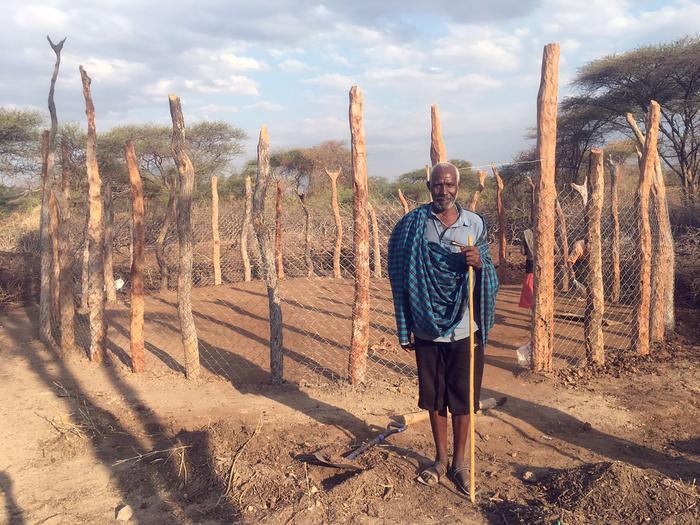In the wilderness of Tanzania, a silent battle unfolds between livestock owners and the native carnivores that threaten their livelihood. As lions, leopards, and hyenas roam the landscapes, the challenging dynamics of human-animal coexistence come into sharp focus. Traditionally, conflicts arise when these apex predators hunt livestock, leading to significant economic losses for farmers who depend on their animals for sustenance. However, a transformative approach is emerging, one that promises not only to protect livestock but also to maintain the ecological balance within this complex ecosystem.
The implementation of fortified corrals, particularly those constructed with chain-link fencing, has shown remarkable efficacy in reducing livestock predation. A recent study conducted by researchers at Colorado State University (CSU) highlights this innovative solution, revealing that not only do these structures safeguard the owner’s animals, they create a ripple effect that positively impacts surrounding livestock keepers as well. This insight drastically changes the previous understanding of how large carnivores interact with their environment when faced with such barriers.
The study analyzed extensive data collected over years, indicating a profound spillover effect; households living close to those with fortified corrals reported significantly fewer livestock attacks. Essentially, these predators tend to avoid neighborhoods with fortified enclosures, opting instead for easier prey elsewhere. This non-lethal intervention not only preserves the livestock but also enhances the overall safety and security of entire communities. This groundbreaking observation represents an essential step toward achieving sustainable cohabitation between humans and wildlife.
This proactive method of conserving livestock has garnered attention because, traditionally, farmers have resorted to lethal measures when faced with predation. Such actions not only threaten the carnivore population but can also create an imbalance in the broader ecosystem. The loss of apex predators like lions and leopards has cascading effects on biodiversity and ecosystem health—factors that ultimately affect human livelihoods. Therefore, the findings from this study that indicate a reduction in conflicts through non-lethal means are promising not only for the farmers but for environmental sustainability.
The research emphasizes the need for a more comprehensive understanding of the interplay between humans, livestock, and predators. The benefits of fortified corrals extend beyond mere protection; they actively reshape the behavioral patterns of local carnivores and promote a more harmonious existence. The tight-knit relationship formed between farmers and conservation organizations like Lion Landscapes has facilitated a data-rich approach, enhancing the knowledge base for effective conservation strategies.
As communities adapt to new forms of livestock protection, the future of predator management looks promising. The idea of coexistence rather than confrontation liberates communities from the cycle of retribution against wildlife. The emphasis shifts from fear and retaliation toward proactive conservation measures that engage local communities in protecting both their livelihoods and the health of their ecosystems. This cultural shift may prove essential in areas worldwide where human-wildlife conflict remains a persistent threat.
While the study did not inquire directly into why predators avoid fenced neighborhoods, the prevailing theory suggests that the increased difficulty of accessing livestock within fortified enclosures compels them to seek easier targets elsewhere. This behavioral change underscores the significance of implementing well-constructed barriers and highlights the ingenuity of utilizing environmental factors to enhance both human safety and wildlife preservation.
Fencing vast national parks like Ruaha presents insurmountable challenges and carries ecological consequences that can isolate wildlife populations. Instead, the focus remains on enhancing local livelihoods while ensuring ecological integrity, exemplifying the delicate balance of conservation efforts that respect both human and wildlife interests. The lessons learned from Ruaha National Park serve as templates for other regions facing similar challenges, encouraging tailored solutions that account for unique circumstances.
As the results of these studies reach a larger audience, an urgent call arises for broader awareness and action. The science of coexistence requires continuous investigation and collaborative efforts among researchers, wildlife managers, and the local community. By gathering comprehensive data and employing adaptive measures, stakeholders can tailor their efforts to mitigate conflict and promote sustainable landscapes where humans and wildlife flourish together.
The chain-link fencing initiative paves the way for conservation practices that extend well beyond geographic confines, offering scalable solutions to regions grappling with similar predation conflicts. By sharing these success stories and practical methodologies, conservation organizations can foster a greater understanding of the essential interactions within ecosystems, ultimately driving positive change globally. The research not only serves as an academic triumph but as a vital stepping stone toward a sustainable future for both people and wildlife.
In conclusion, as the lessons from these Tanzanian landscapes resonate across borders, it becomes clear that fostering coexistence between humans and wildlife requires innovative, non-lethal methodologies. The continued success of interventions such as fortified corrals indicates that a shift in perspective is crucial if we are to navigate these intricate dynamics with compassion and responsibility. Only through disciplined research, evidence-based solutions, and community collaboration can humanity hope to reconcile its needs with the natural world we share.
Subject of Research: The impact of fortified corrals on livestock protection and predator behavior in Tanzania.
Article Title: Beneficial Spillover Effects of Antipredation Interventions Support Human–Carnivore Coexistence
News Publication Date: March 6, 2025
Web References: https://conbio.onlinelibrary.wiley.com/doi/10.1111/conl.13085
References:
Image Credits: Photo by Lion Landscapes
Keywords: human-wildlife coexistence, predation prevention, conservation strategies, livestock protection, ecological balance, wildlife management, behavioral ecology, chain-link fencing, Tanzania, sustainable practices, apex predators.
Tags: apex predator behavior around barrierscarnivore conservation in Tanzaniacommunity-based conservation effortsecological balance in ecosystemseconomic implications of carnivore predationfortified corrals for livestock safetyhuman-carnivore conflict resolutionhuman-wildlife coexistenceimpact of chain-link fencing on wildlifelivestock protection strategiessustainable farming practices in Tanzaniawildlife management solutions





